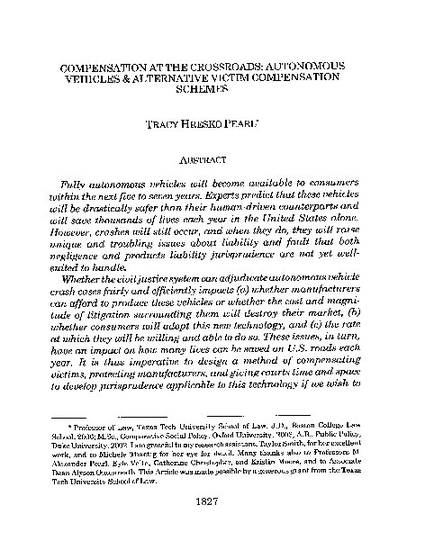
Article
Compensation at the Crossroads: Autonomous Vehicles & Alternative Victim Compensation Schemes
William & Mary Law Review
(2019)
Abstract
Fully autonomous vehicles will become available to consumers within the next five to seven years. Experts predict that these vehicles will be drastically safer than their human-driven counterparts and will save thousands of lives each year in the United States alone. However, crashes will still occur, and when they do, they will raise unique and troubling issues about liability and fault that both negligence and products liability jurisprudence are not yet well-suited to handle.
Whether the civil justice system can adjudicate autonomous vehicle crash cases fairly and efficiently, in turn, impacts (a) whether manufacturers can afford to produce these vehicles or whether the cost and magnitude of litigation surrounding them will destroy their market, (b) whether consumers will adopt this new technology, and (c) the rate at which they will be willing and able to do so. These issues, in turn, have an impact on how many lives can be saved on U.S. roads each year. It is thus imperative to design a method of compensating victims, protecting manufacturers, and giving courts time and space to develop jurisprudence applicable to this technology if we wish to reap the profound benefits that fully autonomous vehicles stand to offer.
While filing a lawsuit in the civil justice system will always be an option for victims of autonomous vehicle crashes, a specially designed, no-fault victim compensation fund offers a sensible way to address the issues identified above and to resolve these cases in a faster and less costly manner. While the use of victim compensation funds is a fairly recent phenomenon in the United States, these funds have been used with great success in a variety of situations and could be used successfully here.
In the model proposed in this paper, an autonomous vehicle crash victim compensation fund would be administered by the National Highway Traffic Safety Administration (NHTSA) and financed by a tax levied on the sale of all fully autonomous vehicles. Victims who wish to seek compensation from the fund would be able to do so via a simple claim form and an agreement to waive their right to sue. Manufacturers, in turn, would be required to participate in a data-sharing and design improvement program as a condition of receiving protection from the fund. This program would both assist NHTSA in gathering the information it needs to regulate autonomous vehicles and reduce the likelihood that a victim compensation fund would reduce manufacturer incentives to improve the safety of their vehicles. Participation by both victims and manufacturers would be voluntary, but the benefits of entering the fund would likely induce high levels of participation from both.
Keywords
- autonomous vehicles,
- self-driving cars,
- liability,
- compensation funds,
- crash victim,
- NHTSA,
- transportation law,
- regulation,
- driverless cars,
- torts
Disciplines
Publication Date
April, 2019
Citation Information
Tracy Pearl. "Compensation at the Crossroads: Autonomous Vehicles & Alternative Victim Compensation Schemes" William & Mary Law Review Vol. 60 Iss. 5 (2019) p. 1827 Available at: http://works.bepress.com/tracy-pearl/3/
